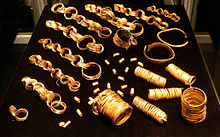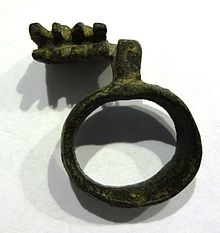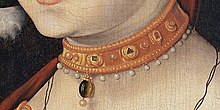Jewellery
Jewelry is an ornament or a measure of embellishment. The term has a broader and a narrower meaning:
- In the broadest sense, jewelry means decorations , i.e. measures to embellish, visually enhance or design rooms, objects or people that represent prosperity . One also speaks of embellishment or decorative ( decorative ) elements.
- In a narrower sense, the term jewelry describes an object that is subjectively perceived as beautiful ( decorative object , but also painting ).
- In the narrowest sense, the customs and objects that are attached to the body and clothing of people and are used for ornament. Jewelry also describes the elements that animals or plants form for analog purposes as a means of communication in the broadest sense.
etymology
The word 'jewelry' has the same origin as the word Geschmeide , which, like Middle High German gesmîdec (easy to work with, designable, supple) and Old High German smîda (metal ), comes from the Germanic root smi (working in metal).
General story
The use of jewelry goes back to the beginnings of mankind : The latest research indicates that people adorned themselves with shells 100,000 years ago - at least 25,000 years earlier than previously thought. Necklaces in the form of both simple and multi-link necklaces are documented as early as the Paleolithic Age ( see Upper Palaeolithic small art ). The people of the Stone Age made their necklaces from mussel and snail shells (e.g. cowrie shells ), animal teeth , fish vertebrae and pearls. Pendants were made from bones , stones and even amber .
With the discovery of the processing possibilities of copper and bronze, these were processed into spiral rolls, plates, metal beads , rings and discs. Even axes and hatchets initially only had a decorative function, as they were too soft in relation to stone tools. The practical use therefore followed the jewelry function with a time lag. The use of organic substances such as animal teeth or amber decreased accordingly. In pre-Christian times, jewelry was a burial gift, along with other objects . In addition, jewelry was not only used in the late Neolithic as a non-verbal system of signs, with whose identity-creating character social, territorial and religious groups could optically differentiate themselves.
With the discovery of metal processing in the Bronze Age through glass production to the development of new materials in the 20th century (e.g. plastic), the range of materials used in jewelry production ( bijouterie ) expanded accordingly. With the use of valuable materials, the jewelry also became an object of value that was used in barter transactions.
Roles and functions of jewelry
Jewelry can have aesthetic functions alone or it can be connected to a practical or social use. Objects of use are often decorated and vice versa, originally purely decorative objects can also be given a use value. Examples of jewelry with a functional function are: the key ring (a short key that was attached to a ring in Roman times) and the signet ring (which was also used in Greek and Roman times to certify contracts on clay or wax). From the point of view of its wearer, a mystical effect can also be practical if z. B. an amulet with a certain symbol is given the ability to avert disaster. Jewelry can also have a signal effect with the z. B. a social status or an affiliation is displayed. Examples are the wedding ring, the bishop's ring or the crown.
Jewelry can also serve as a reserve of value and means of payment (see also the history of money ). In economically less developed countries in particular, gold jewelry is used by women to wear them constantly as a material emergency reserve for the family. Until the 19th century it was customary for Frisian fishermen and seafarers to wear a gold earring, the value of which could be used to finance their Christian burial if they were drowned on a foreign coast.
The body painting can serve not only as a signaling effect (tribal affiliation, war paint) but also to protect the skin from too intense solar radiation or from insects. The make-up made of malachite and galena around the eyes, which has been customary in ancient Egypt since early times, is said to have served, in addition to the aesthetic effect, to protect against flies and the glare effect of the sun. With nipple and genital piercing , in addition to an aesthetic motif, there is also the intention of sexual stimulation through mechanical stimuli .
Body and clothing jewelry

In humans, jewelry is an ornament that is worn on the body. The main purpose of the jewelry is to increase the attractiveness or the status of a person within a society or group or to visibly represent a status (for example the crown jewels ). On the one hand, jewelry is tied to the fascination of the material, for example to the metal with its shine or the color of precious stones, and on the other to the formal aspects of the jewelry shape.
One differentiates between jewelry:
according to shape
by function
according to material
- Metal - or noble metal jewelry such as bronze jewelry , iron jewelry , gold jewelery , platinum jewelry , silver jewelery , silver turquoise jewelry
- Enamel jewelry
- Fossil jewelry
- Hair accessories
- Pearl jewelry
- Gemstones (called particularly valuable and processed jewels )
according to production method
- Filigree jewelry
- 3D printed jewelry
after decorated body part
- Bracelets : bracelet or bangle
- Finger jewelry : finger ring , nail jewelry
- Foot jewelry : anklet , toe ring
- Necklace : necklace , necklace , collar , collar or -reif, torc
- Intimate jewelry
- Headdress : aigrette , diadem , ferronière
- Mouth jewelry
- Nose jewelry
- Ear jewelry : earrings and - plug
after attachment
- Ansteckschmuck , including brooches , needles , pins , badges
- Piercing jewelry
- Jewelry glued to the skin, such as bindis
according to the occasion
according to price
- Costume jewelry , cheap jewelry
according to regional or cultural origin
- Frisian jewelry
- Hümmling jewelry
- Toledo jewelry
- Indian jewelry
- Navajo jewelry
- Hopi jewelry
- Jewelry
- Black Hills jewelry
Closely related to this topic is clothing category: dress jewelry , body painting ( make-up ), tattoos and scars .
Animal jewelry
Animal jewelry is attached to pets and usually serves as a status symbol for the owner.
Classic jewelry for pets is, for example, a harness with small metal disks and the like , as well as blankets, ribbons and other decorations. These are mainly created on official occasions (such as parades ) in order to draw attention to the respective riders / groups and, if necessary, to emphasize the social position of the owners. The same applies to Indian elephants and other animals. The headdress of the animal in charge of the cattle drive should indicate the success of the owner.
In some cases, a functional use is added to the decorative function. A church bell or a little bell makes it easier to localize , for example in cows , sheep or cats . Ornate collars are also used to control dogs .
Decorating the human environment
People's need for a decorative design of their surroundings extends to objects of all kinds, rooms and buildings.
Building decoration
Include building decoration
Book decorations
In the areas of book design and graphic design, the term book decoration stands for all the decorative elements of a typeface.
Decorating on special occasions
Decorating for a limited period of time, which for solemn, official, religious, private or other occasions also includes public space in addition to objects, rooms and buildings, for example at Christmas or Easter, falls within the scope of customs.
See: Categories festivals and customs (religion) , festivals and customs by season , festivals and customs by state .
See also
literature
- Karl Frohnes: Jewelery and costume jewelery in history - forms of jewelery, small arts and crafts and trade through the millennia. Retrieved July 9, 2009 .
- Ulla Stöver: Mon Bijou. History and stories about jewelry. Nymphenburger, Munich 1971. ISBN 3-485-04049-5
- F. d'Errico, C. Henshilwood , M. Vanhaeren, K. van Niekerk: Nassarius Kraussianus shell beads from Blombos Cave, evidence for symbolic behavior in the Middle Stone Age. In: Journal of Human Evolution. Volume 48, No. 1, 2005, pp. 3-24. ISSN 0047-2484 , DOI: 10.1016 / j.jhevol.2004.09.002
- Kerstin Geßner: From ornaments to signs of identities. Socio-cultural considerations based on end-neolithic jewelry in the Middle Elb-Saale region. In: Ethnographisch-Archäologische Zeitschrift , No. 46, 2005, pp. 1–26, http://ufg.geschichte.hu-berlin.de/site/lang__de/4354/default.aspx#gessner
- Christopher Henshilwood et al .: Middle Stone Age shell beads from South Africa. In: Science . Volume 304, No. 5669, 2004, p. 404. ISSN 0036-8075 , DOI: 10.1126 / science.1095905
Web links
Individual evidence
- ^ Friedrich Kluge , Alfred Götze : Etymological dictionary of the German language . 20th ed., Ed. by Walther Mitzka , De Gruyter, Berlin / New York 1967; Reprint (“21st unchanged edition”) ibid 1975, ISBN 3-11-005709-3 , p. 252.
- ↑ Fashion jewelry à la Stone Age. On: Wissenschaft.de from June 23, 2006.
- ↑ Reinhard Pohanka, Die Urgeschichte Europäische, Wiesbaden 2014, p. 93.
- ↑ K. Geßner: From Zierrat to the sign of identities: Socio-cultural considerations on the basis of end-Neolithic jewelry in the Middle Elb-Saale area. Ethnographic-Archaeological Journal, 46, 2005, 1–26.
- ^ Regina Hölzl, Masterpieces of the Egyptian-Oriental Collection, Volume 6 of the series of the Kunsthistorisches Museum Wien, Vienna 2007, p. 28
- ↑ Herders Conversations-Lexikon, Freiburg im Breisgau, 1854, Volume 1, p. 799 ( digitized version )
- ↑ Panel "Volkskunst II, Bauernschmuck" for the article Volkskunst, in: Meyers Konversationslexikon 6th edition 1902 - 1920.







